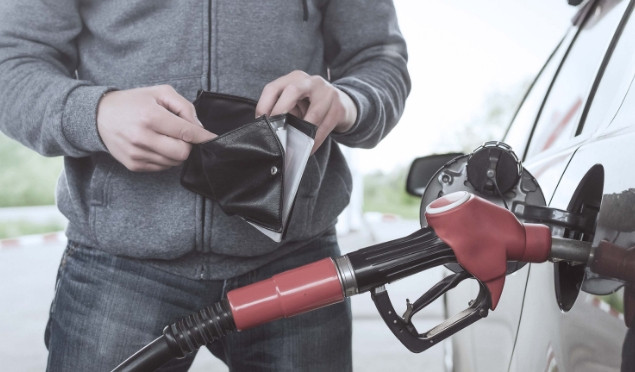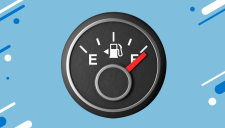How to save on fuel as prices skyrocket

Published on 25th May, 2022 at 02:41 pm
We can’t change the petrol price, but we can make changes to reduce our fuel consumption to stretch those litres further. Here are the small changes that you can make to your car, driving style and lifestyle to save on fuel.
No matter where you live in South Africa, there’s a number that matters to you, whether it impacts you directly or indirectly: the fuel price. And it keeps on climbing, pushing us all to find new, creative ways to fit this expense into our budgets.
In April, we hit an all-time high when coastal dwellers had to fork out R21.24/litre to top up on 95 unleaded petrol at a forecourt, while inland it cost R21.96/litre. That meant to fill up a 55-litre tank would cost R1 168.20 on the coast, and R1 207.80 further inland. May saw a brief period of relief for our pockets, thanks to the reduced General Fuel Levy (GFL), saving us R1.50/litre. There are now indications that, with the GFL being reinstated, we could expect to pay a jaw-dropping R3 more per litre from June. These adjustments are far-reaching, with those who do drive having to tighten their belts to accommodate this grudge expense in their budgets, and those who rely on public transport and other services having to deal with the domino effect fuel price increases have on the price they pay for these.
When will the fuel price increases ease?
According to the Department of Energy, the basic fuel price is calculated based on what’s known as the import parity pricing principle. In a nutshell, this is how much it would cost a South African importer of petrol to buy the petrol from an international refinery, transport it, insure against losses at sea, and land the product on our shores. There is also the cost of local distribution, and a retail mark-up. It’s hard to predict, then, whether the extreme upward trend of increases will continue for months to come. Here are some of the other factors that influence the price you pay at the forecourt:
- International crude oil prices
- International supply and demand of fuel
- Fuel inventory levels
- Geopolitics (unrest, conflict, boycotts, sanctions)
- The ZAR/USD exchange rate
- International refinery margins (a measure of the value contribution of the refinery per unit of input)
- Northern hemisphere weather patterns
Good news! You can still save on fuel
With some adjustments to your vehicle and your lifestyle, you can welcome a few rands back into your wallet. Here’s what experts say will make a difference to your fuel spend, so that you can save for things you actually want to buy.
#1: Where the rubber meets the road
The point of contact between your car and whatever surface it’s going to drive on is under literally a ton of pressure – so ensure you have the right tyres fitted, and that you take good care of them.
The right choice
“The size of your wheels (rim and tyre) has a significant impact on fuel consumption,” says Chris Farrar, retail channel executive at Tiger Wheel & Tyre. Having larger-than-necessary tyres may look great, but you won’t be doing your fuel tank any favours. Farrar explains: “Bigger wheels result in an increase in energy required to turn them due to the change in gearing. They’re also typically heavier, so they add to the load your engine bears to propel the vehicle forward.” There are exceptions to this, but this is generally true, more so for your average hatchback.
There’s also the content of the tyres to think about. Farrar says the quality of your tyres not only determines their longevity, but how much work your engine needs to put in to set your car in motion. Better-quality tyres, he says, likely contain a higher amount of silica in their rubber – which is great if you’d like to reduce your car’s rolling resistance.
What is rolling resistance, and why does it matter? “This is the ease with which a tyre moves over a surface,” says Farrar. “The less resistance it experiences against a surface, the easier or more freely the tyre moves, requiring less ‘work’ or energy to propel the car forward.” In short – less rolling resistance means less fuel used.
Although more premium tyres are desirable, they may not suit every pocket. You can decrease rolling resistance safely by adjusting tyre pressure higher, says Jared Palmer, an automotive technical specialist. “Just make sure it’s within reason and appropriate for the type of vehicle and its purposes, and without compromising the contact patch of the tyre to the ground (ie reducing it),” he says. Consult your local tyre dealer for advice about using the best tyre pressure for your vehicle, with the intention to reduce rolling resistance as much as safely possible, while also considering the intended function of the vehicle and its expected load.
One notable benefit of reducing rolling resistance is reduced wear and tear on the tyres owing to less heat being generated. This indirectly saves you, since you can travel slightly further on your set of tyres.
Take good care
“Underinflated tyres can worsen your fuel consumption,” say Farrar. Check the label on the inside of your car’s driver’s seat door pane to find out the correct air pressure for tyres, then be sure to ask for your tyres to be checked and inflated, if necessary, every time you fill up at a fuel station.
Regular wheel balancing and alignment are also critical for good fuel economy. “Have your tyres balanced and rotated roughly every 8 000km. The front tyres wear out differently to the rear tyres. Irrespective of the driven wheel configuration, this remains true,” says Palmer.
Most importantly, proper wheel alignment carries the largest impact on the life of your tyres; even slightly out, and it will eventually show as a bad wear pattern on your tyre – wasted rubber. Very poor alignment drastically increases rolling resistance, which increases fuel consumption, and you could see your tyres lasting no more than a few weeks. Pay attention to the way your car behaves on the road and tend to the little things diligently.
As a Reality Health, Plus, Core or Club member, you’re eligible for a discounted vehicle assessment and product purchases at Tiger Wheel & Tyre and Tyres & More branches.
#2: Offload the unnecessary
Any items that could weigh your car down are the enemy of fuel cost savings, which is why Palmer recommends removing them. “While it won’t make a major difference, if you don’t need to carry bags of wood or laundry and tools around, just remove them,” he says.
The same goes for modifications to your vehicle. If you’re considering fitting an accessory like a bull bar to your vehicle, bear in mind that the added weight and wind resistance can influence your fuel consumption. “Bakkies with bull bars, heavier off-road tyres (even if the same size), side skirt steps, beefier suspension springs etc, all carry added weight and are saddled with more resistance,” says Palmer. If you’re looking to save on your car expenses, use this guide as a starting point.
As a Reality Core, Plus or Health member, you can save on petrol and enjoy discounted holiday wheels by paying from as little as R285 per day (capped at 200km per day) at Tempest Car Hire, thanks to your Sanlam Reality membership.
#3: Drive smart
Palmer says the biggest factor in fuel consumption (assuming your vehicle is in proper working condition) is always the driver. “You can drive a clapped-out car and still use less fuel than the person driving a newer model of the same car, just faster and demanding more from it,” he explains.
Don’t drive when you can cycle or walk
Quick dash to the corner convenience store? Taking the dogs for a walk? Haul out the bike or lace up your walking shoes, if you can. “Cold running engines are less fuel-efficient, so if your commute is short enough, rather walk or cycle,” suggests Palmer. “An engine that constantly runs in a warming-up state is less fuel efficient.”
If you can, avoid travelling during peak traffic hours to avoid petrol consumption while idling. Often this is unavoidable, but splitting costs by arranging a carpool can help ease the impact on your wallet.
Reality Core, Plus and Health members save on travel, thanks to their Sanlam Reality membership! Get up to 30% discount on Uber transfers to and from major South African airports. Plus, Sanlam clients with Wealth Bonus Lifestyle benefits are eligible for a 20% saving on UberGo and UberX (after hours only).
Get in (the right) gear
According to a paper published in The Scientific World Journal, fuel consumption varies according to the gear changes of a manual driving car. Lower speed ratios (gears) guzzle the most fuel because they are associated with an engine that isn’t sufficiently loaded. It’s why it’s preferable to move into fifth or even sixth gear when you’re on the freeway, having built up enough speed momentum, and leave lower gears for starting and accelerating through your journey. “Keep your revs in a normal range by changing gears at optimal moments,” says Farrar. Listen to your engine to detect when it’s time to gear up or down, and if you’re not sure about the optimal points to change gears, you can ask a technician in the relevant field to help you determine that information based on your specific model of car and the type of transmission it has.
“Don’t try to accelerate in a gear that is too difficult for your engine, since you will be applying much more throttle to muscle out of it, and the time you spend accelerating to your desired speed in the wrong gear is longer than if you had chosen the correct gear in the first place,” adds Palmer.
The Sanlam Money Saver credit card can help you save while you spend. If you fill up and swipe at TotalEnergies, you earn R1 cash back per litre of fuel guaranteed! Find out more here.
Keep it moderate
“Fast and aggressive driving uses more fuel,” says Farrar. This is a behaviour you have the most control over. You can either leave your emotions in your driveway and turn on your ignition in a calm, focused, unhurried state – or you can let them get the better of you, leading to unnecessary speeding and hard breaking, with no thanks from your fuel tank.
Do you save by switching off?
A popular question is whether you save fuel at all by switching off your engine at traffic lights or stop signs, or if it’s better to let your engine idle. If your vehicle uses stop-start technology, Farrar says you can, but he recommends against manually switching off your engine to save on fuel if your vehicle doesn’t have this technology. However, if you anticipate idling for an extended period (hello, peak-hour traffic), switching off can save on fuel.
Also consider the type of engine you have: small petrol engines can typically start up quickly and easily regardless of the use of start-stop technology, but larger engines, and especially larger diesel engines, are better left idling.
What about air con?
The antidote to your sweltering summer on the road is to flick on the air conditioning, but before you do, take note that this, too, adds to the load (stress) on your engine, and therefore how much fuel it takes to power it. The air conditioner is powered by a belt-driven system directly off the engine, and this has a notable and measurable increase in fuel consumption, say Palmer. The air conditioner pump itself could easily be considered a small engine on its own, with reciprocating components. You could expect around 1L/100km additional fuel usage by using the air con all of the time.
So, open the windows, right? Not necessarily. According to The Motorist, open windows cause more drag on the car. This is wind travelling against the car at speed, which also causes the car to waste more fuel.
Ideally, when you’re on the freeway, close the windows and turn on the air con. The power the air con demands from the engine will cause less of a fuel drain than the drag on the car from windows being kept open. Back in the suburbs, limit your air con use and crank those windows open for better fuel consumption.
With petrol prices continuing to climb, the Sanlam Money Saver credit card can help put some cash back in your pocket when you fill up. As a cardholder, earn R1 cash back per litre of fuel guaranteed when you fill up and swipe at TotalEnergies! Find out more here.
Want to learn more?
We send out regular emails packed with useful advice, ideas and tips on everything from saving and investing to budgeting and tax. If you're a Sanlam Reality member and not receiving these emails, update your contact details now.
Update Now







